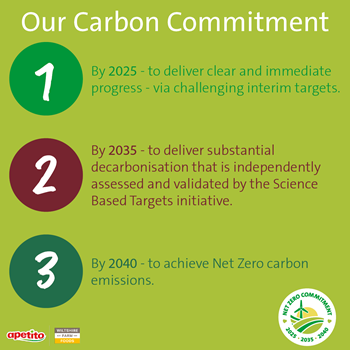Managing climate change
Hear from our very own Lee Sheppard, apetito Director of Corporate Affairs and Policy, Chair of the Sustainability, Food Waste and Procurement Group of the New Hospital Food Standards and member of the Food and Drink Federation Net Zero Steering Group.
Step 1 – The Business Case
This is the first and most fundamental step; if you can get your organisation and people engaged in this project, then everything else will follow; start without it and you will likely struggle. Many organisations struggle with this and see carbon reduction as a task to achieve, rather than focus on the “why”.
The “why” for each organisation will be different, but there are many factors here – focus on the opportunities, not the challenges at this stage. There is undoubtedly a strong moral case; how does decarbonisation support your values? What increased customer demand or new sectors could arise as a result? What new product opportunities might there be? What costs might be avoided?
Step 2 – Footprint
The next step any business should take is to measure their current carbon footprint; if you cannot measure something then you cannot manage it. By measuring your current footprint it’ll quickly show you (and potentially surprise you) where your carbon comes from – its then far easier to galvanise action.
Step 3 – Targets
Once you’ve measured your company’s carbon footprint you then need to identify the reductions necessary to get you on a 1.5° Net Zero pathway and ideally get those targets approved by an independent organisation like the Science Based Targets initiative - this will give you the confidence that you are making the necessary level of reduction consistent with Net Zero.
Step 4 – Mitigation Pathways
Once you understand your footprint and the necessary reductions required, you can now start identifying the key workstreams across your organisation. Based upon your current footprint, you can probably get a good picture of what project groups will be needed. Is it purchasing, ingredients, manufacturing, distribution, packaging and more? Once you have these workstreams, work with each to identify the key projects that will reduce your current footprint. Don’t feel you have to create this on your own. Many trade organisations – such as the Food and Drink Federation create “How To” guides on best-practice that can steer you. Engagement here is key – get the teams involved and get them to own their own space
Step 5 – Embedding
But how do you make this part of your everyday business operations? Reducing your carbon footprint is not a one-time action. You need to look at building it into your investment appraisal processes and into your purchasing decisions. How do you embed sustainable factors into your everyday business decisions? Changing your investment appraisal process to account for a price for carbon or creating a carbon budget against each project are 2 ways of making this happen.


Step 6 – Communication and Advocacy
Sharing your successes is key to igniting interest, not only will this inspire your teams internally, but it may also encourage other people in your industry to make a difference. The key to Net Zero is reducing the carbon in both your direct and indirect operations – you are dependent upon your suppliers and your customers to influence your footprint, so engage with them. You cannot deliver Net Zero without them and joint initiatives will be key as we all look for solutions in this space.
Find out about how we’re making a real difference in ethics and sustainability.
For further information please contact:
